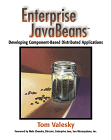A Solid Investment in Enterprise JavaBeans
Well presented, key information about a critical Java technology, with good examples and well-rounded coverage.
ORIGINAL DRAFT
Sun’s introduction of the Enterprise JavaBeans specification and subsequent rapid adoption by numerous vendors ensures its success in the marketplace. More important is the functionally that becomes available to enterprise system designers, developers and administrators, all of which add up to considerable advantages for virtually any corporation, large or small. The only remaining barrier seems to be the cost of high end systems, which run in the $10,000 to $25,000 range. With many open source projects underway, however, this may not be a barrier for long. For serious Java developers, the question of learning to work with EJB is a no brainer, and this book does a pretty good job of laying out the facts in a lucid, instructive manner.
The book is divided into 10 chapters and 3 appendices. The appendices are code listings from chapters 4, 5 and 9. I would have preferred to see the code in with the relevant chapters myself but this is more of a nit pick than a serious detriment. Chapter 1 explores the big picture, covering everything from sockets to component object models. Chapter 2 does a pretty nice job of explaining the EJB architecture and Chapter 3 develops a "Hello World" application in EJB to explain the mechanics and keep things simple. This approach works pretty well and takes the form of a step-by-step set of instructions you can reference in future projects to be sure you’ve covered the basics.
Chapters 4 and 5 explain Session and Entity beans, respectively. Example stateless and statefull session beans and container and bean-managed entity beans are presented and clearly explained. Chapter 6 takes a look at EJB client software, along with related communication mechanisms. Chapter 7 covers deployment, with a look at session and entity bean descriptors. Chapter 8 provides information that makes this book more pragmatic than most, presenting tips, tricks, talking about common traps and other problems you might run across in a real implementation. Chapter 9 implements a complete employee time-tracking application that touches on virtually every aspect of an EJB development effort. Chapter 10 concludes with a look at the future of EJB.
If you work anywhere near enterprise systems or expect to in the future, this book is a great investment that will allow you to leverage your knowledge, and possibly your career, into some of the most interesting areas in recent technology. Enterprise JavaBeans are here to stay and the coverage in these pages does a very nice job of exploring each of the critical areas, preparing you to work effectively with EJB client/servers by presenting information that can easily be absorbed and applied. The book has good examples and you’ll find an evaluation copy of the WebLogic EJB server to experiment with on the CD. Overall, a good buy for the money.
